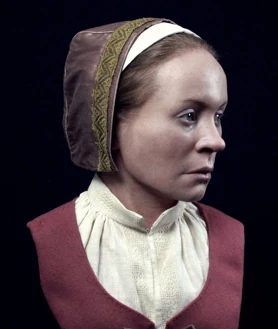They buried her with a padlock on his foot and an iron sickle on his neckso that he could never return from the dead, in an unmarked cemetery in Pien, northern Poland. Her neighbors feared or detested her. They believed that the young woman was a “vampire”like other women of the time, or like that child who was buried in the same place face down and with a similar padlock on his feet. Four centuries later, a team of scientists has reconstructed the face of Zosia with DNA, 3D printing and modeling clay to reveal human history buried by supernatural beliefs.
“It’s really ironic, in a way,” says Swedish archaeologist and artist Oscar Nilsson. «These people who buried her did everything possible to prevent her from coming back from the dead… we We have done everything possible to bring her back to life», he tells Reuters.
Zosia, as the locals named her, was found in 2022 by a team of archaeologists from the Nicolaus Copernicus University in Torun, led by Professor Dariusz Poliński. He wore a silk cap and had a protruding front tooth.


Reconstruction of the woman buried in Pien by Oscar Nilsson
The analysis of his skull suggests that he suffered from a health problem that would have caused him fainting and severe headachesas well as possible mental health problems, according to Nilsson.
Protective padlocks
They placed a sickle on his neck in such a way that the slightest attempt to lift his head would cut it off, and they placed a padlock on his foot. Along with certain types of wood found in the tomb, they were once believed to have magical properties that protected against vampires.
«According to Polish traditions, dangerous people were thought to have two different souls, one good and one bad. The good soul could remain inside the deceased person with a closed lock. “If the evil soul was allowed to take control, a demonic being could emerge: a ‘striga’, later known as a vampire,” he explains.
Zosia’s grave was number 75 in the unmarked cemetery in Pien, on the outskirts of the northern city of Bydgoszcz. Although little is known about her life, because of the objects with which she was buried, Nilsson and Pien’s team suspect that He belonged to a wealthy family, possibly noble. In the 17th century Europe in which he lived, devastated by war, there was a climate of fear in which belief in supernatural monsters was common, according to the archaeologist.
Nilsson began his reconstruction by creating a 3D printed replica of the skull to which he gradually added layers of plasticine “muscle by muscle” until forming a realistic face. To estimate the depth of facial features, he took into account bone structure, combined with information about gender, age, ethnicity and approximate weight.
«It is emotional to see a face that returns from the deadespecially when you know the story of this young woman,” says the Swedish archaeologist, who also reconstructed the face of Juanita, the ice maiden of Ampato sacrificed in an Inca ritual at about 14 years old.
#return #face #vampire #woman #buried #years #sickle #neck

